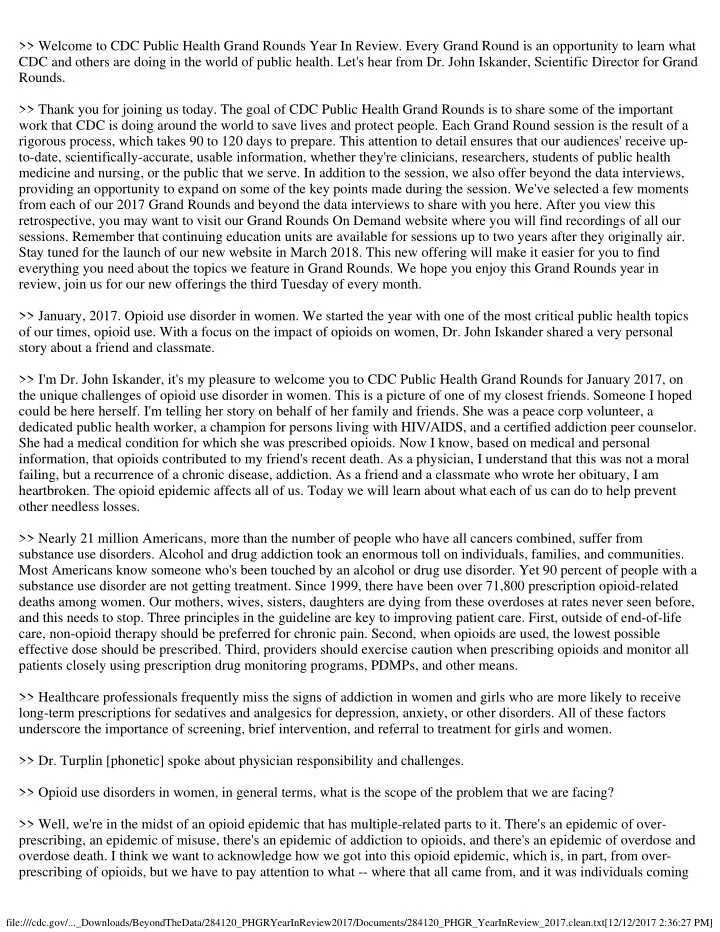

>> Welcome to CDC Public Health Grand Rounds Year In Review. Every Grand Round is an opportunity to learn what CDC and others are doing in the world of public health. Let's hear from Dr. John Iskander, Scientific Director for Grand Rounds. >> Thank you for joining us today. The goal of CDC Public Health Grand Rounds is to share some of the important work that CDC is doing around the world to save lives and protect people. Each Grand Round session is the result of a rigorous process, which takes 90 to 120 days to prepare. This attention to detail ensures that our audiences' receive up- to-date, scientifically-accurate, usable information, whether they're clinicians, researchers, students of public health medicine and nursing, or the public that we serve. In addition to the session, we also offer beyond the data interviews, providing an opportunity to expand on some of the key points made during the session. We've selected a few moments from each of our 2017 Grand Rounds and beyond the data interviews to share with you here. After you view this retrospective, you may want to visit our Grand Rounds On Demand website where you will find recordings of all our sessions. Remember that continuing education units are available for sessions up to two years after they originally air. Stay tuned for the launch of our new website in March 2018. This new offering will make it easier for you to find everything you need about the topics we feature in Grand Rounds. We hope you enjoy this Grand Rounds year in review, join us for our new offerings the third Tuesday of every month. >> January, 2017. Opioid use disorder in women. We started the year with one of the most critical public health topics of our times, opioid use. With a focus on the impact of opioids on women, Dr. John Iskander shared a very personal story about a friend and classmate. >> I'm Dr. John Iskander, it's my pleasure to welcome you to CDC Public Health Grand Rounds for January 2017, on the unique challenges of opioid use disorder in women. This is a picture of one of my closest friends. Someone I hoped could be here herself. I'm telling her story on behalf of her family and friends. She was a peace corp volunteer, a dedicated public health worker, a champion for persons living with HIV/AIDS, and a certified addiction peer counselor. She had a medical condition for which she was prescribed opioids. Now I know, based on medical and personal information, that opioids contributed to my friend's recent death. As a physician, I understand that this was not a moral failing, but a recurrence of a chronic disease, addiction. As a friend and a classmate who wrote her obituary, I am heartbroken. The opioid epidemic affects all of us. Today we will learn about what each of us can do to help prevent other needless losses. >> Nearly 21 million Americans, more than the number of people who have all cancers combined, suffer from substance use disorders. Alcohol and drug addiction took an enormous toll on individuals, families, and communities. Most Americans know someone who's been touched by an alcohol or drug use disorder. Yet 90 percent of people with a substance use disorder are not getting treatment. Since 1999, there have been over 71,800 prescription opioid-related deaths among women. Our mothers, wives, sisters, daughters are dying from these overdoses at rates never seen before, and this needs to stop. Three principles in the guideline are key to improving patient care. First, outside of end-of-life care, non-opioid therapy should be preferred for chronic pain. Second, when opioids are used, the lowest possible effective dose should be prescribed. Third, providers should exercise caution when prescribing opioids and monitor all patients closely using prescription drug monitoring programs, PDMPs, and other means. >> Healthcare professionals frequently miss the signs of addiction in women and girls who are more likely to receive long-term prescriptions for sedatives and analgesics for depression, anxiety, or other disorders. All of these factors underscore the importance of screening, brief intervention, and referral to treatment for girls and women. >> Dr. Turplin [phonetic] spoke about physician responsibility and challenges. >> Opioid use disorders in women, in general terms, what is the scope of the problem that we are facing? >> Well, we're in the midst of an opioid epidemic that has multiple-related parts to it. There's an epidemic of over- prescribing, an epidemic of misuse, there's an epidemic of addiction to opioids, and there's an epidemic of overdose and overdose death. I think we want to acknowledge how we got into this opioid epidemic, which is, in part, from over- prescribing of opioids, but we have to pay attention to what -- where that all came from, and it was individuals coming file:///cdc.gov/..._Downloads/BeyondTheData/284120_PHGRYearInReview2017/Documents/284120_PHGR_YearInReview_2017.clean.txt[12/12/2017 2:36:27 PM]
Recommend
More recommend